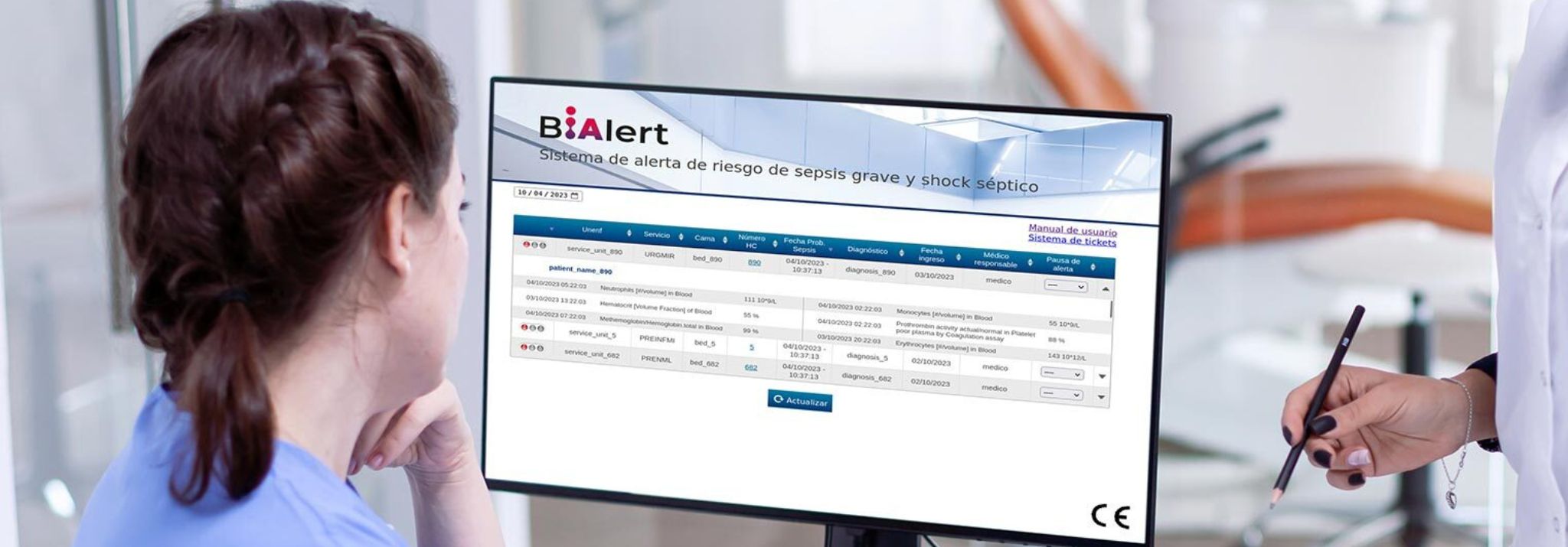BIAlert Sepsis obtains CE marking as a medical device
Artificial Intelligence opens up new possibilities for early and personalised care for sepsis, a time-dependent condition with a 32-50% mortality rate. The Instituto de Ingeniería del Conocimiento (IIC) has been working for some time on an intelligent alert system: BIAlert Sepsis, which has just become the first Spanish AI for sepsis prediction to obtain CE marking (level IIa).
Granted by Intertek Medical Notified Body AB, a body notified by the EU, this certificate guarantees it as a medical device in accordance with the requirements of quality, safety, efficacy and correct information required by EU directives and the Spanish Agency for Medicines and Medical Devices (AEMPS) for its commercialisation.
In this way, BIAlert Sepsis has gone from being a research project to becoming a validated tool in healthcare practice and has already been demonstrating its efficacy for two and a half years at the Hospital Universitario Son Llàtzer in Palma de Mallorca. Here it has been shown to predict the risk of sepsis 24 hours in advance and with a predictive capacity of 96%, after being trained on data from more than 200,000 Spanish patients.What does
BIAlert Sepsis bring to the healthcare sector?
Given the complexity of sepsis diagnosis, which is highly variable and depends on different patient conditions, artificial intelligence could support the medical professional and complement the Sepsis Code already implemented in 170 Spanish hospitals.
BIAlert Sepsis combines medical knowledge with AI techniques that infer new sepsis cases after analysis of historical medical data, reducing the high false positive and false negative rates (65%) of protocols. For example, at Hospital Universitario Son Llàtzer, up to 200 new cases of sepsis have been identified in one year that would not have been detected if only the medical rules had been applied.
In practice, BIAlert Sepsis runs on the hospital's updated data, automatically uploading it from the medical record without generating additional work for the practitioner. It collects information every 30 minutes from each admitted patient and issues an alert or recommendation if it detects a possible sepsis, for the clinician to assess and validate. It is based on the analysis of up to 200 clinical variables relevant to the diagnosis.
"It is a small revolution in what we were doing until now, which we knew was not enough, as we had not been able to identify sepsis early. Now we no longer have to wait for the first organic dysfunctions to appear," stresses Marcio Borges, coordinator of the hospital's Multidisciplinary Sepsis Unit, member of the IdISba Sepsis Group and president of the Sepsis Code Foundation.
Development and adaptation of BIAlert Sepsis
In 2018, the Instituto de Ingeniería del Conocimiento (IIC) began working on the algorithm with the Hospital Universitario Son Llàtzer, following a tender launched by the Fundación Instituto de Investigación Sanitaria Illes Balears (IdISBa). Within the framework of a research project, BIAlert Sepsis was developed in two phases.
First, a retrospective analysis of the historical data of 200,000 patients was carried out. From this medical information, the determinant variables for the prediction of sepsis were identified and the Machine Learning model was trained.
Then, in the prospective phase, the model was tested and validated, proving that it was capable of alerting the medical team in real time of possible cases of sepsis. This is where the tool adapts to the casuistry of each hospital: "Sepsis is not defined in the same way in all healthcare facilities. It is essential to collaborate with the medical team to carry out this local adaptation. If we want the tool to be accurate, we need to personalise and customise," explains Elisa Martín, director of the Health Predictive Analytics area of the Instituto de Ingeniería del Conocimiento (IIC).
BIAlert Sepsis is designed to be integrated into the clinical practice and dynamics of each hospital. According to the IIC methodology, the adaptation of the tool requires the knowledge and trust of the medical team, which supervises the process and validates the results of the models, while at the same time seeing that the tool can add value to their work. Already in practice, the decision of the medical specialist remains the only valid one, the system only suggests to review the data of a given patient, with a high probability of developing sepsis, in order to act more quickly.
How is BIAlert Sepsis implemented in a hospital?
The experiences and tests, both technical and clinical, carried out with BIAlert Sepsis have served to support the CE marking that certifies it as a medical device. Now, following its integration at the Hospital Universitario Son Llàtzer, two other hospitals, the 12 de Octubre in Madrid and the Complejo Hospitalario Universitario de Albacete, are incorporating this AI software into their patient management systems. All of them have had or will have to follow a series of steps to do so:
- It must be approved by the hospital's ethics committee.
- A data protection / confidentiality agreement is signed.
- All you need is a server, which any centre can have, with a computer with some memory (nothing exceptional).
- A dictionary is developed for standardised labelling of clinical criteria in each hospital. It does not generate additional work for the professional.
- It is installed remotely and a remote check is also carried out to confirm that everything is OK.
- The system reads data from the patient's medical record every 30 minutes at the most, although readings can be programmed up to every 15 minutes.
- The system issues an alert when there is a significant chance that the patient will develop sepsis in the next 24 hours.
- The medical team tests the patient for the pathogen that will cause sepsis.
- The patient receives medication to prevent sepsis.
Because of data protection law, the hospitals cannot share data with each other, but the algorithm is learning more and more from experience, so its effectiveness can only increase, providing ever more accurate predictions. BIAlert Sepsis is a technological solution made in Spain that can change the paradigm of sepsis management and realize the promise of the application of AI in healthcare.


